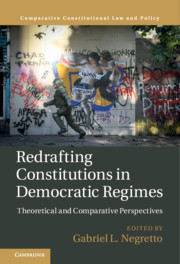Book contents
- Redrafting Constitutions in Democratic Regimes
- Comparative Constitutional Law and Policy
- Redrafting Constitutions in Democratic Regimes
- Copyright page
- Dedication
- Contents
- Tables
- Contributors
- Acknowledgments
- 1 New Constitutions in Democratic Regimes
- Part I Conceptual, Normative, and Empirical Issues
- Part II Case Studies
- 6 The Difference Power Diffusion Makes
- 7 Democratic Constitutional Replacements and Majoritarian Politics
- 8 Thailand’s Democratic Moment
- 9 Political Elites and the People
- 10 The Anatomy of Constitution Making
- Index
- References
7 - Democratic Constitutional Replacements and Majoritarian Politics
The Cases of Poland (1993–1997) and Hungary (2010–2011)
from Part II - Case Studies
Published online by Cambridge University Press: 29 August 2020
- Redrafting Constitutions in Democratic Regimes
- Comparative Constitutional Law and Policy
- Redrafting Constitutions in Democratic Regimes
- Copyright page
- Dedication
- Contents
- Tables
- Contributors
- Acknowledgments
- 1 New Constitutions in Democratic Regimes
- Part I Conceptual, Normative, and Empirical Issues
- Part II Case Studies
- 6 The Difference Power Diffusion Makes
- 7 Democratic Constitutional Replacements and Majoritarian Politics
- 8 Thailand’s Democratic Moment
- 9 Political Elites and the People
- 10 The Anatomy of Constitution Making
- Index
- References
Summary
In both Poland and Hungary new constitutions were adopted after elections that provided a new government with the formal capacity to control the process by excluding opposition interests. However, whereas in Poland the constitution was in the end the result of a compromise among a plurality of political interests, in Hungary the government unilaterally imposed the constitution with negative consequences for the future of democracy in the country. In this chapter, we argue that a more consensual constitution-making process was possible in Poland because opposition forces, in spite of their meager results in terms of parliamentary representation, were able to exert influence over the process through extra-institutional and institutional means. In contrast to Hungary, where opposition groups were extremely weak or discredited, in Poland extra-parliamentary opposition maintained significant support among voters and functioned as an effective political constraint on dominant parties. Thanks to their strength outside formal political institutions, opposition forces in Poland were able to induce incumbents to make changes in the constitution-making procedures that allowed them to have some clout in the drafting of the constitution.
- Type
- Chapter
- Information
- Redrafting Constitutions in Democratic RegimesTheoretical and Comparative Perspectives, pp. 155 - 174Publisher: Cambridge University PressPrint publication year: 2020
References
- 1
- Cited by

